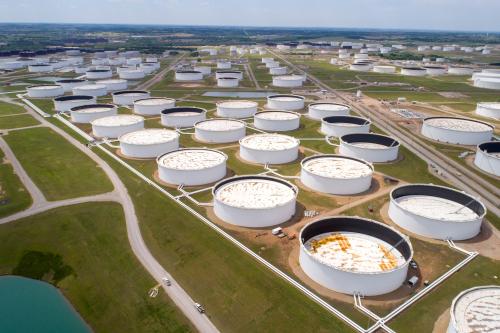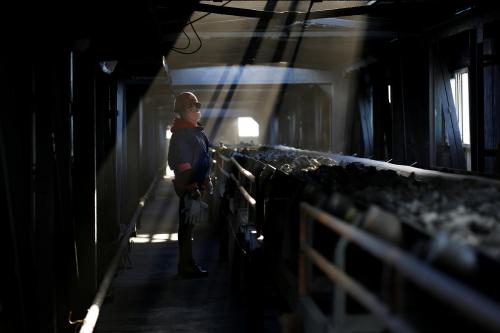This op-ed was originally published by Project Syndicate.
The COVID-19 pandemic has brought economic and social activity around the world to a near standstill. As a result, carbon dioxide emissions have declined sharply, and the skies above some large cities are clean and clear for the first time in decades.
But “degrowth” is not a sustainable strategy for averting environmental disaster. Humanity should protect itself from climate change not by reducing economic activity, but rather by making it more resilient, robust, and sustainable.
The ongoing pandemic has powerfully demonstrated the cost of neglecting catastrophic tail risks. The risks tied to climate change, while unfolding more gradually, are at least as great as those posed by COVID-19. Although the international community is rightly focusing its efforts on the immediate health and economic crisis, it should not lose sight of this threat.
Encouragingly, the rapid reduction in the cost of green technologies in recent years has increased the competitiveness of clean energy generated from sources such as solar and wind. As long as policymakers create a credible expectation of long-term profits by committing to strong environmental standards and providing a long-term framework for eliminating fossil-fuel subsidies, investors will likely be willing to incur the fixed costs of green investments.
Indeed, these technological advances imply that the trade-off between climate protection and economic progress has become much smaller than we previously thought. Even when the cost-benefit calculus excludes the immediate negative externalities, such as air pollution, that arise from CO2 emissions, green investment has clearly become economically viable even without subsidies. In fact, renewable energy sources like solar and onshore wind power, recently became the cheapest option for much of the world.
But it remains to be seen whether this competitiveness can be sustained in the face of the collapse in fossil-fuel prices caused by the pandemic. U.S. benchmark crude fell below $20 per barrel in late April, its lowest level since 1999. The price of natural gas also is cratering. And although oil prices may recover slightly as producers cut output, they are likely to remain depressed for quite some time.
While lower oil prices will give consumers’ finances a welcome boost—with lower-income households benefiting more in relative terms—they will make renewables less competitive, just at a time when the world should be engineering a climate-friendly recovery. Moreover, a prolonged period of low oil and gas prices would also make green energy sources less competitive in the future by discouraging investment in clean-technology research and development.
But it doesn’t have to be that way. In fact, the oil-price collapse presents an excellent opportunity to advance climate policies by levying or increasing carbon taxes at a reduced political cost. In late 2014, when oil prices had declined to $45 per barrel from a high of $108 that June, one of us suggested that policymakers waste no time and introduce carbon taxes. Because taxes affecting politically sensitive oil products like gasoline would only partly offset the steep decline in oil prices, such measures would face less resistance than before.
The case is even stronger today, because oil prices have fallen far below their level then. While the user price of fossil fuels would remain historically low even with a substantial carbon tax, such a levy would blunt the negative impact of these extremely low prices on the competitiveness of renewables, thus making a climate-friendly recovery easier to achieve.
This opportunity should not be lost, because the world is at a crucial juncture regarding climate change. Recovering from the pandemic-induced economic collapse will require large new investments around the world. Whether these investments replicate the past in a rush to return to “normalcy” or lay the foundation for sustainable and resilient growth will determine the planet’s future.
To illustrate, a tax of $200 per metric ton of carbon (equivalent to $54 per metric ton of CO2) would result in an increase of less than 50 cents per gallon for gasoline in the United States, which currently costs less than $1.80 per gallon on average. At about $2.30 per gallon, the price of gas at the pump—the most politically sensitive variable in most countries, as demonstrated by the “Yellow Vest” protests in France—would remain at historically low levels in the aftermath of COVID-19 despite a sizable carbon tax. Moreover, making the carbon tax flexible by tying it to the price of oil could enable it to function as an automatic stabilizer. For example, for every $5-per-barrel increase in the oil price, the carbon tax could be lowered, but by a smaller amount, in order partly to mitigate the increased cost to consumers. Likewise, for every $5-per-barrel decrease in the oil price, the tax could be raised by a somewhat larger (but still small) amount.
This way, the carbon price would increase over time in line with the overall progress of climate policies, while buffering consumers from oil-price volatility and boosting fiscal revenues. As one of us explained in 2016, once such a carbon tax is in place, “it will become a little-noticed, politically uncontroversial part of pricing for gasoline (and other products)—one that produces far-reaching benefits.”
Of course, carbon pricing would have to be in effect across sectors and economies in order to provide a direct price incentive for climate-change mitigation efforts and to complement regulatory standards and other measures. For example, while oil remains dominant in the transport sector, natural gas is now the primary source of electric-power generation. But natural gas, though a lot cleaner than fuel oil, still emits CO2 and must be replaced by renewables to achieve net-zero emissions. Even if electric vehicles fully replace gasoline-powered cars and trucks, they will still only be as clean as the electricity that powers them.
Climate policies must address many other related issues and use an array of instruments. Carbon pricing is no silver bullet. But today’s ultra-low oil prices, rather than discouraging investment in clean energy, offer an ideal opportunity to strengthen the pricing component of the toolkit and ensure that the post-pandemic recovery helps create a climate-resilient economy for the long term.








Commentary
Op-edThe carbon tax opportunity
May 6, 2020